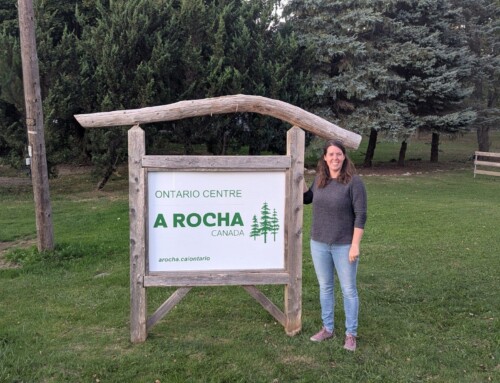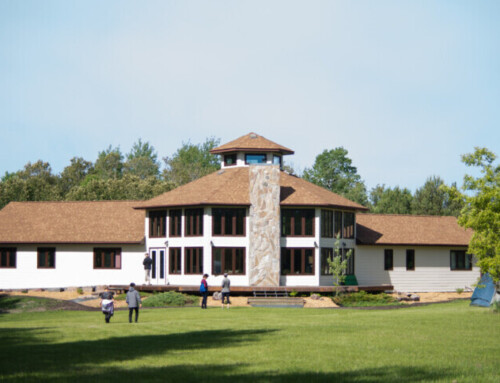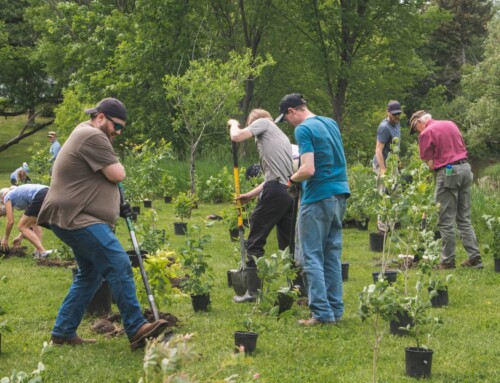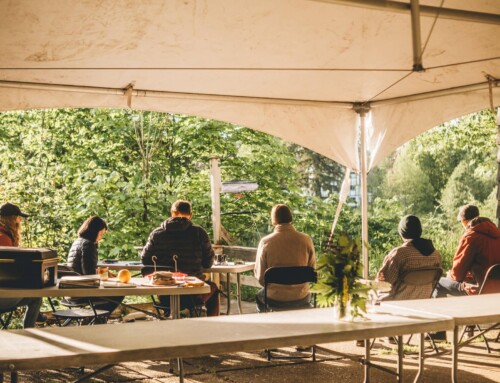Saving Wildlife Habitat Land around Surrey, BC
MVRD Board Meeting Outcome
February 26, 2022 update: The Regional Growth Strategy amendment to allow industrialization of South Campbell Heights was passed in the February 25 Metro Vancouver Board Meeting, after a slim majority vote.
Despite this disappointing outcome, A Rocha is committed to continue caring for the river, wetlands, forests and species at risk; scrutinising individual development plans; and advocating for the most sustainable approaches at each step. We will count on your prayers and support in the road ahead.
The History
Click on each timeline item to read more in detail.
In 2011, the City of Surrey designated 660 acres surrounding A Rocha’s Brooksdale Environmental Centre as a ‘Special Study Area’, indicating that future land use planning was expected, with potential for changes to the existing land use. This area is referred to as “South Campbell Heights.”
In the fall of 2014, the City began a Local Area Plan (LAP) planning process for this same area. This began with an environmental study and an industrial lands study, followed by community consultation in which A Rocha was heavily involved.
The City then created and, in 2017, approved a land use concept plan for South Campbell Heights. This proposed land use plan included a mix of residential, conservation, commercial and employment uses and represented a compromise of competing interests in the area.

Appendix I of the 2017 Land Use Concept Plan for South Campbell Heights, generated by the City of Surrey. https://www.surrey.ca/sites/default/files/corporate-reports/RPT_2017-R171.pdf
In order to finalize their 2017 land use concept plan, the City of Surrey applied to Metro Vancouver Regional Planning to amend Metro Vancouver’s Regional Growth Strategy (Metro 2040) and extend the Urban Containment Boundary to allow for the proposed land uses.
In May of 2018, the Metro Vancouver Regional District Board voted to refer the application back to the City of Surrey to consider an alternative proposal, due to concerns about the inappropriate use of rural lands, increasing land speculation and impacts to food security and agricultural lands (MVRD Board Minutes, May 25, 2018).
In the Spring of 2021, the City of Surrey released a revised land use concept plan and hosted an online survey, requesting feedback from the public about the new proposal. The revised land use plan proposes mixed employment (commercial, industrial, office and accessory uses) and conservation and recreation lands. All of the other previously proposed uses were removed. After a lengthy public hearing on July 26, 2021, the City of Surrey approved the revised land use plan and again made an application to Metro Vancouver Regional Planning to amend the Regional Growth Strategy and extend the Urban Containment Boundary.
On October 8, 2021 the Metro Vancouver Regional Planning Committee recommended that the Metro Vancouver Regional District Board approve Surrey’s request and proceed with the amendment. It is expected that the Metro Vancouver Regional District (MVRD) Board will vote on the proposed amendment on October 29, 2021.
2021 Land Use Concept Plan for South Campbell Heights (Photo: City of Surrey)
What is the Urban Containment Boundary?
This tool is a vital part of Metro Vancouver’s long-term regional plans to accommodate and contain urban growth for the next 30 years. The South Campbell Heights LAP application from the City of Surrey both in 2018 and 2021 require an extension of this urban boundary.
According to Metro Vancouver:
The Urban Containment Boundary is intended to maintain a stable, long-term footprint for urban development. The establishment of the UCB reinforces the protection of agricultural, conservation and rural lands, and provides predictability for locating urban uses, major regional transportation and infrastructure investment.
The lands within the UCB have sufficient capacity to accommodate all of Metro Vancouver’s projected residential growth to 2041.

Metro Vancouver’s current Urban Containment Boundary lines (Photo: Metro Vancouver Regional District).
Our Position
A Rocha has consistently expressed its concern with and opposition to changing the allowable land uses in this area. Not only would it have an impact on operations at the Brooksdale Environmental Centre, but more importantly there are significant environmental concerns with the proposal. Proponents of the plan cite the ‘urgent need for employment lands’ as the primary reason for approval of this proposal.
A Rocha has been working to restore and enhance the TATALU (Little Campbell River) and the surrounding watershed for 20 years. Changing the land use designation would allow for the first large-scale commercial and industrial development along the entire 30km river. None of the many long-time stewards* of the river believe that a proposal of this scale and type can be placed on either side of the river without damaging the health and integrity of the river. The conservation buffers, proposed along the river, are not enough to mitigate the impacts of development of this kind. The surrounding rural and agricultural lands are key habitat for a number of species at risk and are critical for groundwater and river recharge.
Salmon spawning in the TATALU / Little Campbell River, within A Rocha’s Brooksdale Environmental Centre property. (Video: Dannie Piezas)
Partner Groups and Organizations
Several local groups and stakeholders are partnered in opposing the current LAP process, including:
How You Can Help
Join us in voicing opposition to the South Campbell Heights Regional Growth Strategy amendment request. Here’s what you can do before February 25, when the Metro Vancouver Board may next vote to approve the land use amendment:
- Write a letter/e-mail or make a phone call to each of the MVRD Board members asking them to vote in opposition to the proposed amendment. Reference the South Campbell Heights – Metro Vancouver 2040: Shaping Our Future Land Use Designation Amendment Request from the City of Surrey in your correspondence. It is advisable to keep the e-mails short and succinct with main points summarized to be more effective.
- Refer to the contact directory for the MVRD Board for their phone numbers and e-mail addresses.
- Pre-fill your e-mail with the Board members’ e-mail addresses.
- Sign and share the online petition.
- Share this page with your friends and family and ask them to write too (click the share buttons at the border of this page).
Rationale for Opposition
Here are some of the reasons to oppose changing the land use designation for the South Campbell Heights area:
- The area has high biodiversity and ecological significance in the Metro Vancouver Region, and is therefore best left rural and agricultural. The area contains rich intact forest habitats, pastured aquifer recharge areas, federally listed species at risk, and the threatened Little Campbell River (a Class A, salmon bearing river). The 2015 Madrone environmental study demonstrated that “any development would have a critical negative impact on the watershed and aquifer recharge”.
- This proposal requires extending the Urban Containment Boundary (UCB). The UCB is one of Metro Vancouver’s flagship planning policies, created to accommodate and contain urban growth within the region for the next 30 years. This proposal would allow for commercial and industrial sprawl outside the existing UCB only 10 years after the boundary was established. This is a dangerous precedent.
- Member jurisdictions across the Metro Vancouver Region have declared a Climate Emergency. Climate change mitigation requires preserving large intact forests, watershed habitats, and pasturelands as carbon sinks; helping to store carbon, moderate temperatures, and offset greenhouse gas emissions. Conversely, large scale industrial commercial facilities, and their massive paving footprints for facilities and parking, release carbon and contribute to the urban heat island effect.
- Urban development will result in the loss of rural and agricultural lands. Proponents of the plan would have us believe the lands in the area are not farmable. However, A Rocha operates a regenerative vegetable farm within the area, providing food to hundreds of people in Metro Vancouver and contributing to local food security. Further, the permeable surface, and species habitat provided by rural and agricultural lands is invaluable.
- There are opportunities to densify and redevelop existing employment lands located closer to urban centres, rather than developing rural and agricultural lands. This is also more efficient from a servicing and transportation perspective.
Thank you for your support and involvement as we continue to seek to protect and enhance the Little Campbell Watershed.
Media Coverage
Read the local coverage of the concerns around the South Campbell Heights LAP with input from A Rocha Canada, local residents, environmental groups, subject experts, columnists, or elected officials.
- July 7, 2022 – Surrey Now-Leader – Event to raise awareness of threat to South Surrey river, farmland this weekend
- June 24, 2022 – Surrey Now-Leader – City of White Rock resists signing off on Metro Vancouver strategy
- March 4, 2022 – Aldergrove Star – LETTER: Langley resident critical of Metro Van board’s Campbell Heights vote
- March 3, 2022 – Cloverdale Reporter – EDITORIAL: Hey, Surrey, what’s the hurry on South Campbell Heights development?
- February 26, 2022 – North Shore News – Metro Vancouver board votes to industrialize Surrey’s Little Campbell River area
- February 26, 2022 – Global News – Controversial Surrey industrial land expansion gets green light from Metro Vancouver
- February 26, 2022 – Global News – Metro Vancouver board votes narrowly in favour of a plan to develop South Campbell Heights in Surrey
- February 25 2022 – CBC News – Despite objections, regional government narrowly approves Surrey’s plan to expand industrial lands
- February 25 2022 – Daily Hive – South Campbell Heights industrial lands get final approval from Metro Vancouver
- February 25, 2022 – Aldergrove Star – Metro Vancouver board endorses Surrey’s South Campbell Heights development plan
- February 16, 2022 – Surrey Now-Leader – South Campbell Heights development proposal to return to Metro Vancouver board
- January 31, 2022 – Vancouver is Awesome – ‘Not a box we tick’: Lack of First Nation consultation delays controversial Surrey industrial park
- January 30, 2022 – Global News – Semiahmoo First Nation hails pause on proposed Surrey industrial area expansion
- January 29, 2022 – CBC News – Regional government directs Surrey to seek added consultation on plans for expansion of industrial lands
- January 28, 2022 – Surrey Now-Leader – Metro Vancouver hits pause button on South Campbell Heights development proposal
- January 5, 2022 – Peace Arch News – Metro to decide Jan. 28 on South Campbell Heights redesignation
- December 17, 2021 – Vancouver Sun – As climate change wallops B.C., activists ask: Is this the right time for Surrey to cut down trees?
- December 6, 2021 – Partnership for Water Sustainability in British Columbia – METRO VANCOUVER’S ENDANGERED STREAMS: “Floods are now Canada’s most common and destructive ‘natural’ disasters. They are dramatic and widely covered events. Often overlooked are the smaller, more frequent events that threaten to destroy some of our most important waterways,” wrote Daphne Bramham, Vancouver Sun columnist (December 2021)
- December 6, 2021 – Peace Arch News – South Campbell Heights plan needs more studies, consultation: outdoor recreation council
- December 5, 2021 – Vancouver Sun – Daphne Bramham: Protecting metro’s endangered rivers requires ‘more precautionary approach’
- December 4, 2021 – Outdoor Recreation Council of BC – BC’s Most Endangered Rivers: 2021/22 Urban Streams Edition
- December 2, 2021 – The Georgia Straight – Cheryl Wiens: Scrap the plan for South Campbell Heights
- November 28, 2021 – Global News – Environmentalists fighting to save Surrey salmon bearing river
- November 16, 2021 – Langley Advance Times – GREEN BEAT: Campbell Heights area can and should be saved
- July 29, 2021 – Surrey Now-Leader – COLUMN: A Rocha’s Brooksdale Environmental Centre in Surrey offers rich experience
- July 27, 2021 – Peace Arch News – Surrey council moves South Campbell Heights plan forward
- July 26, 2021 – CBC News – Proposed rezoning of 600 acres in Surrey’s South Campbell Heights raises conservation concerns
Summary of Actions to Take
The Metro Vancouver Board Meeting on February 25 has now passed, with the vote outcome being in favour of the industrialization of South Campbell Heights.
And share this page with your friends and family using the buttons at the border of this webpage!

An aerial shot of A Rocha’s Brooksdale Environmental Centre and the surrounding lands within South Campbell Heights. (Photo: Martin Grypma)










